Think back to what you learned about the Civil Rights Movement. My bet is that you learned that it started in the 1950s when Rosa Parks refused to give up her seat on the bus. I mean, why wouldn’t she? She was a tired old lady who was trying to get home from work. Then poof! The Civil Rights Movement started, and we all lived happily ever after. Of course, I’m being super sarcastic here.
The Civil Rights Movement is complex. Unfortunately, our society continues to whitewash and oversimplify it. We focus on “nice” black people who protested peacefully. Society teaches us that black people were tired of separate drinking fountains. Yes, black people were tired of subpar accommodations, economic disparity, and disenfranchisement. But, the biggest reason for the modern Civil Rights Movement was lynching. Black people were tired of being murdered.
Rosa Parks
When Rosa Parks refused to give up her seat, she was tired. Tired of the bullsh*t. She was the secretary of her local chapter of the NAACP. It was planned. She was PLANTED there. There had been several people who refused to give up their seats before her.
History loves to remove agency from African Americans. Loves to make our actions seem accidental. Nope, the NAACP CHOSE Rosa Parks to refuse to give up her seat. And she wasn’t the first to do it. (Ever heard of Claudette Colvin? No? Here’s an article you need to read).
On December 1, 1955, she refused to give up her seat. What was Parks thinking about at the time? Was she thinking about her long day as a seamstress? Nope.
“I thought of Emmett Till, and when the bus driver ordered me to move to the back, I just couldn’t move.” ~Rosa Parks
So who was Emmett Till?
He’s an important part of the modern Civil Rights Movement’s journey. While we often think the Civil Rights Movement started in the 1950s with Dr. Martin Luther King, Jr, it didn’t. The battle for Black civil rights has been fought for centuries.
But, there was a catalyst that sparked the modern Civil Rights Movement. The murder of a 14-year-old black boy named Emmett Till was that catalyst.
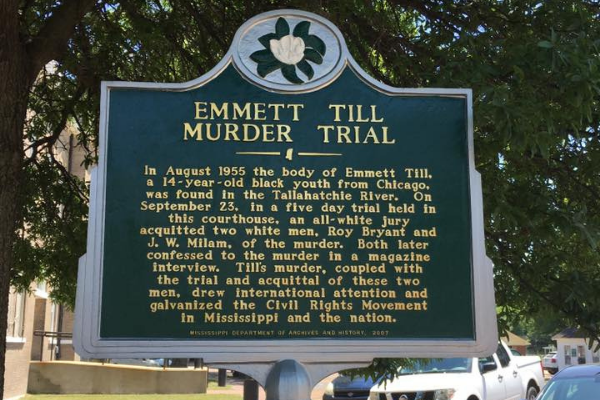
Here’s a quick summary of what happened.
Emmett Till was 14 and lived in Chicago. In the summer of 1955, he went down to the Mississippi Delta to visit his family. One day while playing with some friends, he entered Bryant’s Grocery. Then, he allegedly whistled at the woman behind the counter. (You’ll see why I say “allegedly” later on). A white woman. The wife of the store’s owner.
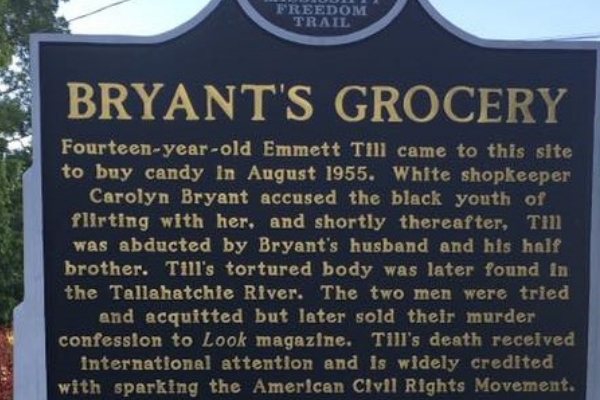

Click here to see what Bryant’s Grocery looked like in 1955.
Later the store owner, Roy Bryant, and J.W. Milam went to Till’s great uncle’s house. They took Till out of the house and BRUTALLY murder him. There was a trial. And I bet you can guess what the outcome was. Yup. A jury of their homies acquitted them.
Oh, it gets better. Later on, they sold their story to a reporter for $4,000 and admitted that they murdered Emmett Till.
You may be wondering: “why weren’t they tried again?” Well, we have a little thing in the 5th Amendment. It protects us against double jeopardy. No new trial. That means they got away with murder. (Double jeopardy is meant to protect the innocent, not d-bags like Milam and Bryant).
Note: I don’t talk this way to my students, but we’re all adults here.
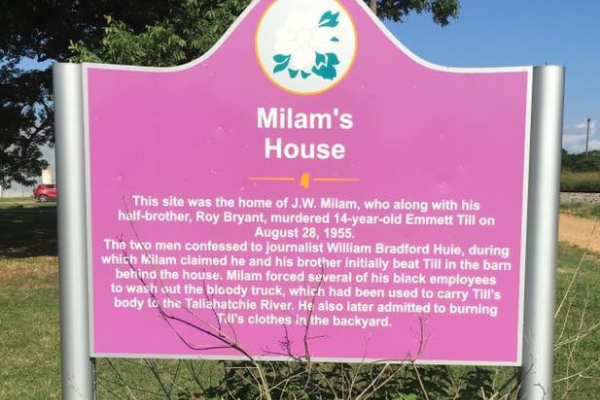
So that’s the short of it. I recommend doing more reading on the topic or using the resources I linked below to learn more.
I’m going to share the way I teach about Emmett Till with my students. I will also share a little about a summer program I did in the Mississippi Delta. Part of that program focused on the Delta Blues, and the other part focused on Emmett Till. (All of the photos in this post were taken by me during this trip).
I teach about Emmett Till in my U.S. History classes, AP Government, and standard Government classes. I use different essential questions.
U.S. EQ: How was the African American response to the murder of Emmett Till an act of rebellion in the 1950s?
Civics EQ: Why was the lynching of Emmett Till the catalyst of the modern Civil Rights Movement?
So here’s what I do:
Step 1: The Death of Emmett Till by Bob Dylan
This song is powerful. I first heard it when I was in Mississippi doing the summer program I mentioned. If you haven’t heard it, I HIGHLY recommend that you listen to it. Here’s a version from YouTube. It’s not the exact one I use. I prefer the one from Apple Music, this will work too.
As anyone who has heard Bob Dylan, you know he doesn’t have a good singing voice. It’s super important to prep the kids for what they’re going to hear. You don’t want them to snicker or to laugh when they hear his voice for the first time. I make sure that I warn them. I let them know it’s ok not to like this style of music or Dylan’s singing voice.
But, I expect them to be mature. This song and topic are too serious for goofing around. Doing that has always worked, and the kids get a lot out of the song.
I give the students the lyrics. As they listen, they follow along. Once the song is over, they answer the questions in the Do Now section of their handout.
Step 2: Eyes on the Prize
Eyes on the Prize is my favorite Civil Rights documentary. Is it old? Yes. Is it dry sometimes? Yes. BUT, collectively, it does the best job of getting at the emotion of the movement.
The clip I use for Emmett Till is from the episode called Awakenings. The clip shows interviews with members of Emmett Till’s family. It does a good job of explaining what happened. There’s also footage from Bryant and Milam’s trial.
A quick warning. I always let the kids know that they show a picture of Till’s body. I encourage them to look at it. The kids need to understand why this murder outraged so many people. And why it moved people into action more than ever before.
If you haven’t seen it, you’ll have to purchase the series from Amazon. It’s no longer available on Youtube. You’ll want to watch minutes 5:10-25:54.
While the students watch, I have them answer the guiding questions. I tell them not to focus too much on the questions, they can always answer them after the video clip.
Finally, you’ve got to debrief. It’s a sad, horrific topic, and many of your students will need to decompress.
Step 3: Recent News Articles
We look at a few news articles about the Till case. You can assign this for classwork or for homework, depending on your time constraints.
The articles are recent:
- U.S. Reopens Emmett Till Investigation, Almost 63 Years After His Murder
- Emmett Till’s Murder, and How America Remembers Its Darkest Moments
- How Author Timothy Tyson Found The Woman At The Center Of The Emmett Till Case
These articles (especially the last one) are super important. Carolyn Bryant admits she LIED. SHE LIED. Here’s a section from the Vanity Fair article:
Timothy Tyson, a Duke University senior research scholar, reveals that Carolyn—in 2007, at age 72—confessed that she had fabricated the most sensational part of her testimony. “That part’s not true,” she told Tyson, about her claim that Till had made verbal and physical advances on her. As for the rest of what happened that evening in the country store, she said she couldn’t remember.
I have no words for this. How despicable! If I believed in Hell, I’d buy her an express ticket.
This angers the students (obviously), so I make sure that we have time to talk about it.
Step 4: Closure
I have the students answer the essential question for the lesson. The EQ differs depending on if it’s a civics lesson or a U.S. History lesson. I have the students write a solid paragraph, and I make sure to give them feedback.
Bonus:
Ok, so of course you can’t use this in your classes. But I wanted to share it because it was one of the most impactful experiences I’ve ever had.
In 2016, I participated in a FREE week-long summer program. The program was through the National Endowment of the Humanities. It was called The Most Southern Place on Earth. (It was incredible, I HIGHLY recommend that you apply for it). The program was based at Delta State University in Cleveland, MS, in the heart of the Mississippi Delta. We studied the Delta Blues and the Emmett Till case.
Click here for more info on programs from the National Endowment of the Humanities
We met two of Emmett Till’s cousins who were in the house with him when Milam and Bryant took him. Then, we went to Money, MS, and saw Bryant’s grocery. We also went to the courthouse where the trial took place. It was a history nerd’s dream.
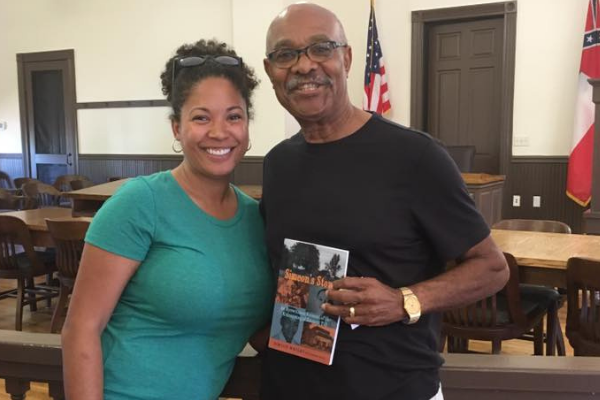
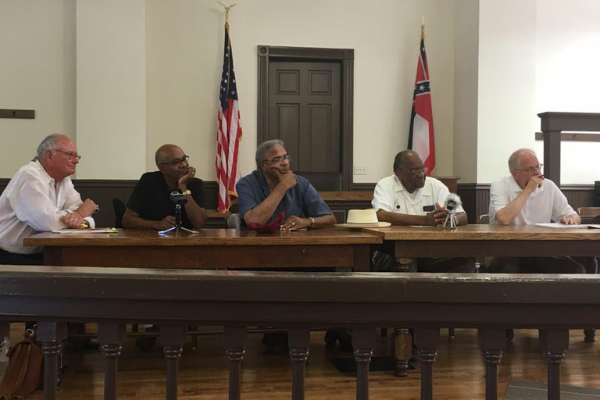
Another Idea for teaching about Emmett Till
Earlier this school year my friend, Angela, shared a resource with me that I thought was super cool. She used it in our mini-unit of Cultural Appropriation. The resource is a painting called “Open Casket,” which depicts Emmett Till in his casket.
The issue that many people had with the painting is that a white artist created it. Some people argue that it was inappropriate for a white woman to paint this, while others don’t see a problem with it. This could be a very interesting conversation to have with your students!
Welp, that’s all I’ve got for you! Let me know, do you teach about Emmett Till? If so, how? Leave a comment below!
Want to read more from the Teach Hungry Movement? Click here to check out other posts!
Thank you for sharing. This is a great post! The story of Emmett Till is an incredibly sad one. His body is buried at Burr Oak Cemetery in Alsip, IL, not far from where I grew up. As a south side of Chicago resident, his story was one that I learned in school.
In 2009, the FBI blew open a case at the cemetery because the then owners were exhuming bodies nearby Till to resell the plots at higher costs. Many bodies were misplaced, and the FBI was there for months. So many families showed up begging to know where their loved ones were, but couldn’t be let in during the investigation.
How terrible that even in death people have found ways to capitalize on his murder.
This is terrific! I can tell you are a master teacher. My younger son is dyslexic and he will have to read Mississippi Trial, 1955 in sixth grade. I’ve been putting together “cheat sheets” for him – a list of characters, summary of events, etc. so he won’t be intimidated by a jungle of words. I also plan to have him watch the PBS documentary before he reads it so he can visualize it.
this was incredibly informative. I am in college and for my final project we have to watch a film that portrays US history, and I chose Till. Gut-wrenching film. But I live in New York and so, as you mentioned, when I learned about the CRM, I learned about Roda Parks and Dr. Martin Luther King Jr. I had no idea who Emmett Till was until I watched the movie.